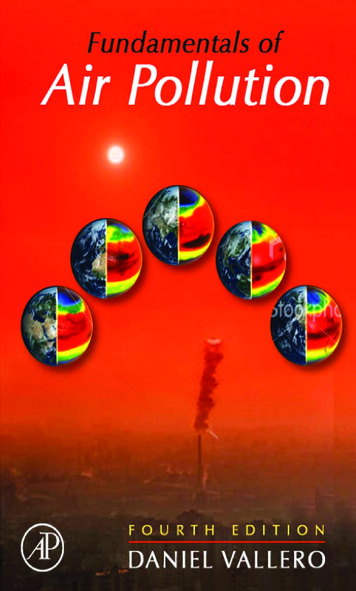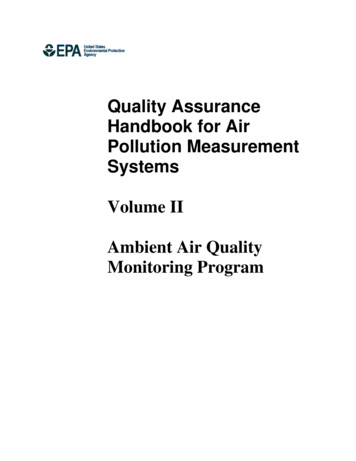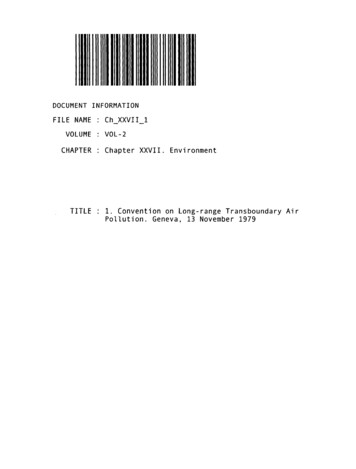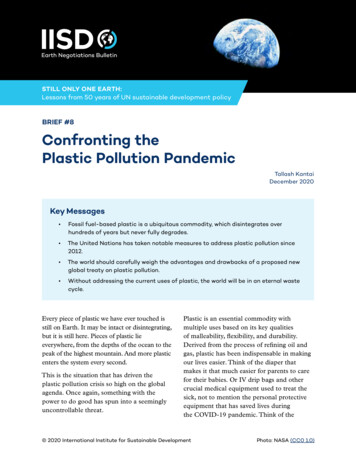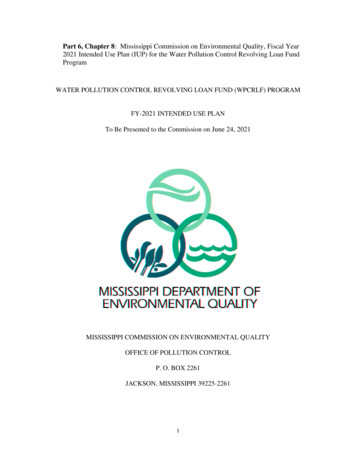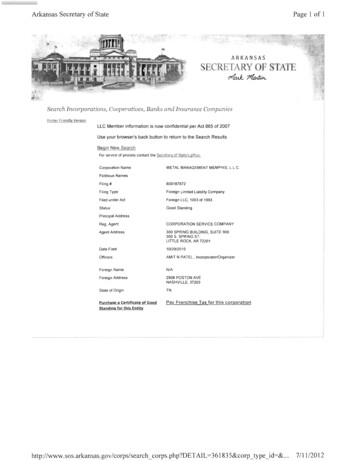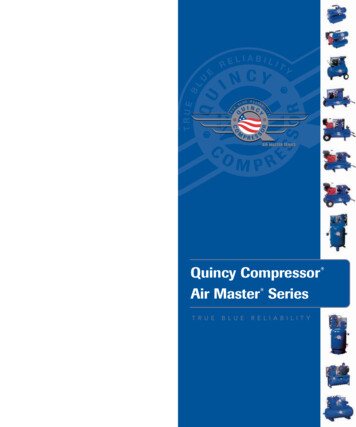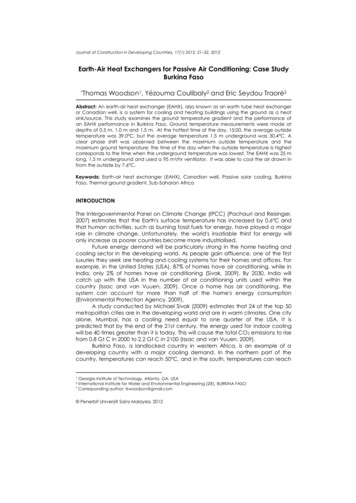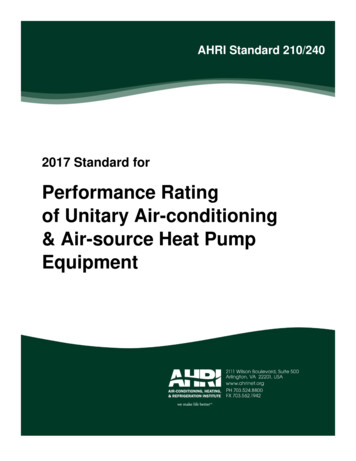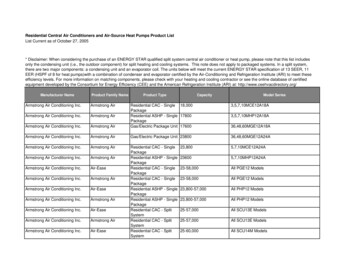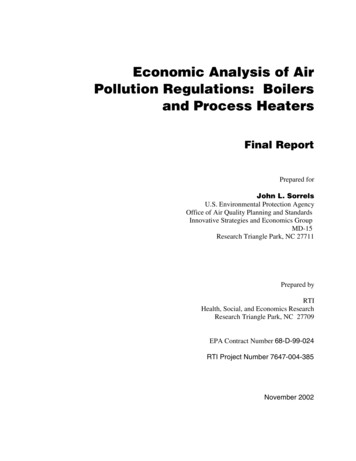
Transcription
Economic Analysis of AirPollution Regulations: Boilersand Process HeatersFinal ReportPrepared forJohn L. SorrelsU.S. Environmental Protection AgencyOffice of Air Quality Planning and StandardsInnovative Strategies and Economics GroupMD-15Research Triangle Park, NC 27711Prepared byRTIHealth, Social, and Economics ResearchResearch Triangle Park, NC 27709EPA Contract Number 68-D-99-024RTI Project Number 7647-004-385November 2002
EPA Contract Number68-D-99-024RTI Project Number7647-004-385Economic Analysis of AirPollution Regulations: Boilersand Process HeatersFinal ReportNovember 2002Prepared forJohn L. SorrelsU.S. Environmental Protection AgencyOffice of Air Quality Planning and StandardsInnovative Strategies and Economics GroupMD-15Research Triangle Park, NC 27711Prepared byMichael P. GallaherAlan C. O’ConnorBrooks M. DeproRTIHealth, Social, and Economics ResearchResearch Triangle Park, NC 27709
This report contains portions of the economic impact analysis report that are related to theindustry profile.
SECTION 2BOILER AND PROCESS HEATER TECHNOLOGIESThe three categories of combustion devices affected under the proposed regulations areindustrial, commercial, and institutional (ICI) boilers and process heaters. Although theirprimary function is to transfer heat generated from fuel combustion to materials used in theproduction process, the applications for boilers and process heaters are somewhat different.As a result, the primary industries using boilers may not be the same as those using processheaters. It is important to note that throughout this report the terms “boilers and processheaters,” and “units” are synonymous with “ICI boilers and process heaters.” Utility boilersprimarily engaged in generating electricity are not covered by the NESHAP under analysisand are therefore excluded from this analysis.Boilers are combustion devices used to produce steam or heat water. Steam is producedin boilers by heating water until it vaporizes. The steam is then channeled to applicationswithin a facility or group of facilities via pipes. Steam is an important power and heatingsource for the U.S. economy. It is used in the preparation or manufacturing of many keyproducts, such as paper, petroleum products, furniture, and chemicals. Steam is also used toheat buildings and to generate the majority of the electricity consumed in this country. Thereare literally thousands of boilers currently being used in the United States throughout a widevariety of industries.Process heaters are primarily used as heat transfer units in which heat from fuelcombustion is transferred to process fluids, although they may also be used to transfer heat toother nonfluid materials or to heat transfer materials for use in a process unit (not includinggeneration of steam). Process heaters are generally used in heat transfer applications whereboilers are inadequate. Often these are uses in which heat must be transferred attemperatures in excess of 90 to 204 C (200 to 400 F). Process heaters are used in thepetroleum refining and petrochemical industries, with minor applications in the asphaltconcrete, gypsum, iron and steel, and wood and forest products industries.Since one of the main uses of boilers is to generate steam, some of the characteristics ofsteam are discussed in this section. This section also provides an overview of the varioustypes of boiler and process heater characteristics and designs.2.1 Characteristics of SteamSteam, an odorless, invisible gas of vaporized water, may be interspersed with waterdroplets, which gives it a cloudy appearance. It is produced naturally when undergroundwater is heated by volcanic processes and mechanically using boilers and other heating2-1
processes. When water is heated at atmospheric pressure, it remains in liquid form until itstemperature exceeds 212 F, the boiling point of water. Additional heat does not raise thewater’s temperature but rather vaporizes the water, converting it into steam. However, ifwater is heated under pressure, such as in a boiler, the boiling point is higher than 212 F andmore heat is required to generate steam. Once all the water has been vaporized into steam,the addition of heat causes the temperature and volume to increase. Steam’s heating andwork capabilities increase as it is produced under greater pressure coupled with highertemperatures. As steam escapes from the boiler, it can be directed through pipes to drivemechanical processes or to provide heat.The steam used in most utility, industrial, and commercial applications is referred to as“clean steam.” Clean steam encompasses steam purities ranging from pure, solid-free steamused in critical processes to filtered steam for less demanding applications. The varioustypes of clean steam differ in steam purity and steam quality. Steam purity is a quantitativemeasure of contamination of steam caused by dissolved particles in the vapor or by tinydroplets of water that may remain in the steam. Steam quality is a measure of how muchliquid water is mixed in with the dry steam (Fleming, 1992). Firms select the levels of steamquality and steam purity for their applications based on the sensitivity of their equipment toimpurities, water droplet size, and condensation as well as the requirements for theirproduction process. Using clean steam minimizes the risk of product contamination andprolongs equipment life. Although there are infinite possible levels of water purity andquality, the term “clean steam” generally refers to three basic types of steam: filtered steam—produced by filtering plant steam using high-efficiency filters.Filtered steam is generally of high steam quality because most large waterdroplets and other contaminants will be filtered out. clean steam—steam that is frequently produced from deionized and distilledwater. Deionized and distilled water is free of dissolved solids and ions, whichmay corrode pipework. pure steam—similar to clean steam except that it is always produced fromdeionized and distilled water.Steam applications can be categorized by the amount of pressure required: hot water,low pressure, and high pressure. Low pressure is 0 to 15 pounds per square inch (psi) andhigh pressure steam is above 15 psi (Plant Engineering, 1991). Hot water systems, whichgenerate little steam, are primarily used for comfort applications, such as hot water for abuilding. Low pressure applications include process heat and space heating. High pressuresteam applications are more frequently used in industrial and utility applications. Some highpressure applications require that the steam be superheated, a process which ensures that thesteam is free of water droplets, to avoid damaging sensitive equipment.Electric cogenerators, such as large factories and processing facilities, use steam to drive2-2
turbines to generate electricity. A conventional steam electric power plant burns fossil fuels(coal, gas, or oil) in a boiler, releasing heat that boils water and converts it into high-pressuresteam (see Figure 2-1). The steam enters a turbine where it expands and pushes againstblades to turn the generator shaft and create electric current. In this way, the thermal energyof steam becomes mechanical energy, which is converted into electricity. Steam used todrive turbines generates most of the electric power in the United States (TXU, 2000).Industrial operations use steam to perform work such as powering complex machineryoperations, in the same way that electric utilities use steam to rotate turbines. Textile mills,pulp and paper mills, and other manufacturing outfits are examples of facilities that usesteam to run machinery. Steam also provides heat and pressure for manufacturing processes.Industrial establishments use steam to provide heat for drying or to heat and separatematerials. For example, the paper industry uses steam to heat rollers that dry paper duringthe final stages of the production process. Petroleum refineries and chemical producers usesteam to heat petroleum, raw materials, and other inputs to separate inputs into theirconstituent components or to facilitate chemical interactions. In addition to theseapplications, steam is employed in many other industrial processes, including textileproduction, wood working, furniture making, metal working, food preparation, and themanufacture of chemicals. Substitutes for using steam as process heat include electricalheating equipment, infrared, and other radiant drying techniques. Electricity may be used topower machinery, as well. However, switching from steam-powered to electricity-powered2-3
Figure 2-1. Generating Electricity: Steam TurbinesSource: Texas Utilities (TXU). 2000. “Generating Electricity: Steam Turbines.” As obtained in September2000. http://www.txu.com/knowledge/energy lib/generating01.html .machinery would require significant equipment retrofits or replacement.Other steam applications include heating, sanitation, food processing and preparation,and cleaning. In addition to using boilers to heat water, factories, hospitals, governmentbuildings, schools and other large buildings use boiler-generated steam to provide spaceheating. Substitutes for boilers in heating air and water include electrical water and spaceheaters; furnaces; and other heating, ventilation, and air conditioning equipment.2-4
2.2 Fossil-Fuel Boiler CharacterizationSection 2.2 discusses the different classes of fossil-fuel boilers, the most common heattransfer configurations, and the major design types. The discussion indicates the type(s) offuel that each design can use to operate.2.2.1Industrial, Commercial, and Institutional BoilersIndustrial, commercial, and institutional boilers are primarily used for process heating,electrical or mechanical power generation, and/or space heating. Industrial boilers are usedin all major industrial sectors but primarily by the paper products, chemical, food, andpetroleum industries. It is estimated that the heat input capacity for these boilers is typicallybetween 10 and 250 MMBtu/hr; however, larger industrial boilers do exist and are similar toutility boilers (EPA, 1997b). Commercial/institutional boilers are generally smaller than theindustrial units, with heat input capacities generally below 10 MMBtu/hr. These unitsnormally supply the steam and hot water for space heating in a wide range of locations,including wholesale and retail trade, office buildings, hotels, restaurants, hospitals, schools,museums, government buildings, and airports. Five hundred ninety-three of the 3,615 unitspotentially affected by the floor alternative for the proposed regulation arecommercial/institutional units.A boiler system includes the boiler itself, associated piping and valves, operation andsafety controls, water treatment system, and peripheral equipment such as pollution controldevices, economizers, or superheaters (Plant Engineering, 1991). Most boilers are made ofsteel, cast iron, or copper. The primary fuels used by boilers are coal, oil, and natural gas,but some use electricity, waste gases, or biomass.Boilers may either be erected onsite (field-erected boilers) or assembled at a factory(packaged boilers). Packaged boilers are typically lower in initial cost and more simple toinstall. However, field-erected boilers may have lower operating costs, less maintenance,and greater flexibility because the furnace or convection pattern chosen to meet requiredsteam pressure, capacity, and fuel specifications is tailored to the boiler’s potential use (PlantEngineering, 1991). Applications requiring more than 100,000 pounds of steam per hour areusually equipped with a field-erected boiler.2.2.2Heat Transfer ConfigurationsThe heat transfer configuration of a boiler refers to the method by which heat istransferred to the water. The four primary boiler configurations are watertube, firetube, castiron, and tubeless. Most industrial users tend to rely on either watertube or firetubeconfigurations.In a watertube boiler, combustion heat is transferred to water flowing through tubeslining the furnace walls and boiler passes. The furnace watertubes absorb primarily radiativeheat, while the watertubes in the boiler passes gain heat by convective heat transfer. These2-5
units have a wide range of heat input capacities (ICI units range from 0.4 to 1,500MMBtu/hr) and can be either field erected or packaged.1 Watertube boilers with heat inputcapacities greater than 200 MMBtu/hr are typically field erected.Because firetube, cast iron, and tubeless heat transfer configurations typically have heatinput capacities below 10 MMBtu/hr, they will not generally be covered by the proposedNESHAP. Therefore, this profile focuses on those boiler types that use watertube heattransfer configurations.2.2.3Major Design TypesThis section summarizes the five major design types for fossil fuel industrial boilers thatwill be covered by the proposed NESHAP. It also discusses, where possible, the fuels used,capacity, and assembly method of each of these types of boilers.2.2.3.1Stoker-Fired Boilers (Coal)These units use underfeed air to combust the coal char on a stationary grate, combinedwith one or more levels of overfire air introduced above the grate. There are three types ofstoker units: spreader stokers, underfeed stokers, and overfeed stokers.Stokers generally burn all types of coal, with the exception of overfeed stokers, which do notburn coking bituminous coals. Stokers can also burn other types of solid fuel, such as wood,wood waste, and bagasse. Spreader stokers are the most common of these boiler types andhave heat input capacities that typically range from 5 to 550 MMBtu/hr. However, some ofthese boilers have capacities as high as 1,500 MMBtu/hr. Smaller stoker units (i.e., thosewith heat input capacities less than 100 MMBtu/hr) are generally packaged, while largerunits are usually field erected.2.2.3.2Pulverized Coal Boilers (Coal)Combustion in pulverized coal-fired units takes place almost entirely while the coal issuspended, unlike in stoker units in which the coal burns on a grate. Finely ground coal istypically mixed with primary combustion air and fed to the burner or burners, where it isignited and mixed with secondary combustion air. Depending on the location of the burnersand the direction of coal injection into the furnace, pulverized coal-fired boilers can beclassified into three different firing types: single and opposed wall, tangential, and2-6
cyclone.Of these types, wall and tangential configurations are the most common. These firingmethods are described further in Sections 2.2.3.4 and 2.2.3.5.2.2.3.3Fluidized Bed Combustion (FBC) Boilers (Coal)FBC is an integrated technology for reducing sulfur dioxide (SO2) and NOx emissionsduring the combustion of coal. In a typical FBC boiler, crushed coal and inert material(sand, silica, alumina, or ash) and/or a sorbent (limestone) are maintained in a highlyturbulent suspended state by the upward flow of primary air from the windbox locateddirectly below the combustion floor. This fluidized state provides a large amount of surfacecontact between the air and solid particles, which promotes uniform and efficient combustionat lower furnace temperatures than conventional coal-fired boilers. Once the hot gases leavethe combustion chamber, they pass through the convective sections of the boiler, which aresimilar or identical to components used in conventional boilers.For the FBCs currently in use in all sectors, coal is the primary fuel source, followed indescending order by biomass, coal waste, and municipal waste. The heat input capacities ofall ICI FBC units generally range from 1.4 to 1,075 MMBtu/hr.2.2.3.4Tangentially Fired Boilers (Coal, Oil, Natural Gas)The tangentially fired boiler is based on the concept of a single flame zone within thefurnace. The fuel-air mixture projects from the four corners of the furnace along a linetangential to an imaginary cylinder located along the furnace centerline. As fuel and air arefed to the burners and the fuel is combusted, a rotating “fireball” is formed. Primarilybecause of their tangential firing pattern, which leads to larger flame volumes and flameinteraction, uncontrolled tangentially fired boilers generally emit relatively lower NOx thanother uncontrolled boiler designs.Utilities primarily use this type of boiler. Coal is the most common fuel used by theseunits. Tangentially fired boilers operated by utilities are typically larger than 400 MW, whileindustrial ones almost always have heat input capacities over 100 MMBtu/hr. In general,most units with heat input capacities over 100 MMBtu/hr are field erected.2.2.3.5Wall-fired Boilers (Coal, Oil, Natural Gas)Wall-fired boilers are characterized by multiple individual burners located on a singlewall or on opposing walls of the furnace. In contrast to tangentially fired boilers, each of theburners in a wall-fired boiler has a relatively distinct flame zone, and the burners in wallfired boilers do not tilt. Superheated steam temperatures are instead controlled by excess airlevels, heat input, flue gas recirculation, and/or steam attemperation (water spray).Depending on the design and location of the burners, wall-fired boilers are referred to assingle wall or opposed wall.2-7
Wall-fired boilers are used to burn coal, oil, or natural gas, and some designs featuremultifuel capability. Almost all industrial wall-fired boilers have heat input capacitiesgreater than 100 MMBtu/hr. Opposed-wall boilers in particular are usually much larger than250 MMBtu/hr heat input capacity and are much more common in utility rather than inindustrial operations. Because of their size, most wall-fired units are field erected. Fielderected watertube boilers strictly designed for oil firing are more compact than coal-firedboilers with the same heat input, because of the more rapid combustion characteristics of fueloil. Field-erected watertube boilers fired by natural gas are even more compact because ofthe rapid combustion rate of the gaseous fuel, the low flame luminosity, and the ash-freecontent of natural gas.2.3 Process Heater CharacterizationProcess heaters are heat transfer units in which heat from fuel combustion is transferredto materials used in a production process. The process fluid stream is heated primarily forone of two reasons: to raise the temperature for additional processing or to make chemicalreactions occur. This section describes the different classes of process heaters and majordesign types.2.3.1Classes of Process HeatersThe universe of process heaters is divided into two categories: indirect-fired process heater—any process heater in which the combustion gasesdo not mix with or exhaust to the atmosphere from the same stack(s) or vent(s)with any gases emanating from the process or material being processed. direct-fired process heater—any process heater in which the combustion gasesmix with and exhaust to the atmosphere from the same stack(s) or vent(s) withgases originating from the process or material being processed.Indirect-fired units are used in situations where direct flame contact with the materialbeing processed is undesirable because of problems with contamination and ignition of theprocess material. Direct-fired units are used where such problems are not an importantfactor. Emissions of indirect-fired units consist solely of the products of combustion(including those of incomplete combustion). On the other hand, direct-fired units willgenerate emissions consisting not only of the products of combustion, but also the processmaterial(s). This means that the emissions from indirect-fired process heaters will be genericto the fuel in use and are common across industries while emissions from direct-fired processheaters are unique to a given process and may vary widely depending on the processmaterial. Only indirect-fired process heaters are considered under this proposed regulation.Many direct-fired process
RTI Health, Social, and Economics Research Research Triangle Park, NC 27709 . . As steam escapes from the boiler, it can be directed through pipes to drive mechanical processes or to provide heat. The steam used in most utility, industrial, and commercial applications is referred to as . and other
